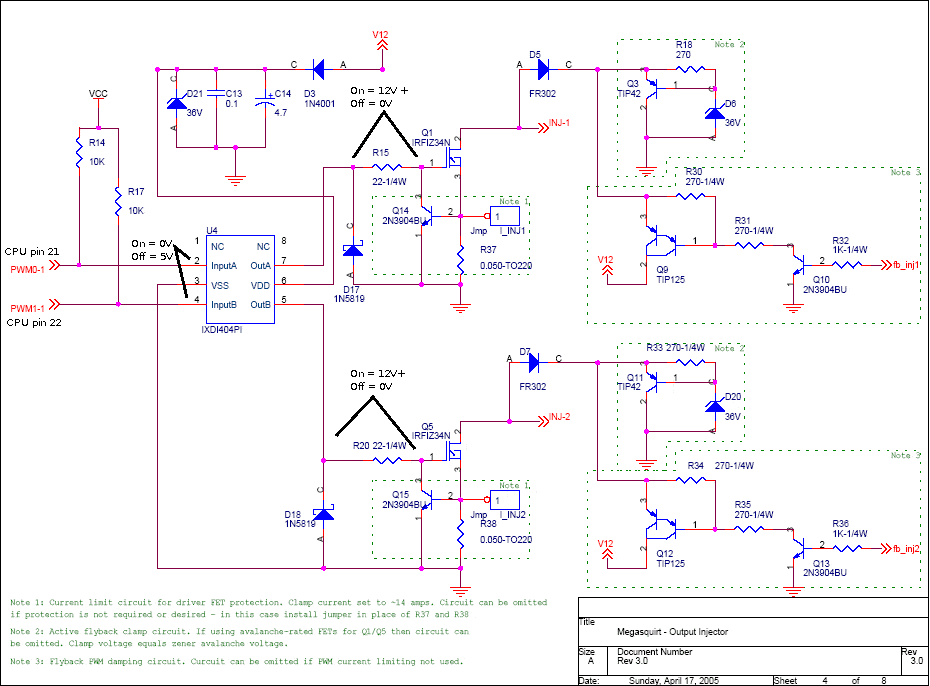Got a problem with the injector drivers on your MegaSquirt? This article will walk you through how to troubleshoot them. It is written for the V3.0 and V3.57 boards. The V2.2 is similar but the component names are different. It does not cover the MS3Pro line, MicroSquirt, MS3X, or MSPNP Gen 2, which use different injector driver circuits.
You will need the following tools:
- Stimulator or JimStim
- Stimulator power supply or 9V battery
- Volt meter
- Some lengths of test wire
To begin with, remove the case lid and processor (or daughter card, in the case of MS2 or MS3) so we can concentrate on the main board, and power the ECU up on the Stim. The injector LEDs should be off. Use a bit of wire to touch the U1 socket pins 21 (in the upper left hand corner if you’re looking at the board with the Bowling & Grippo text at the lower edge – the U1 socket is “upside down”) and 22 (just below it) to ground. The injector LEDs on your Stim should come on. If they do, the board is working correctly. If not, here’s what to check to fix it. Time to get out the volt meter.
Here’s the injector circuit you will be working with. To put the injectors in the on state, connect U1 (CPU) pins 21 and 22 to ground. To put them in an off state, don’t connect these pins to anything.
First, check pins 2 and 4 on U4. If they’re not getting 5 volts in the off state, turn the power off and ohm out R14 and R17, and make sure you have continuity to the CPU.
U4 is an inverting driver. If you don’t see its output on pin 7 go high when pin 2 is grounded, or pin 5 go high when pin 4 is grounded, you’ve got a bad U4 or a lack of power on pin 6. Same if it’s stuck high when it gets 5 volts on the input. Note that if you have a 9 volt battery, the points I’ve marked at “12V+” are going to be lower, more like 8 volts. You’ll usually see somewhere around 12 volts on a power supply. If you’re seeing more like 10 volts, don’t panic; it’s still working OK. Time to move on. If pin 6 does not have power, this can be a failed D3 or D21 diode, a shorted C14 capacitor, or a damaged trace on the board.
Check the input signal on pin 1 of Q1 and Q5. It will be a little lower than the voltage at U4, but not by much. If the voltage has disappeared, power it off and check the ohms on R15 or R20 as appropriate. Either R15 or R20 has failed, or the transistor in the current limiting circuit (Q14 or Q15) has shorted out and needs to be replaced.
If the signal is making it to Q1 or Q5, but the injector driver isn’t working, first check for continuity from pin 2 of the FET to the DB37. If that checks out, and the injector driver is failing to turn on, replace Q1 (for injector 1) or Q5 (for injector 2). If the injector driver is stuck on, it could be same transistor, but it could also be the flyback circuit. To find out which one it is, desolder D5 (for injector 1) or D7 (for injector 2). If the output is still stuck on, it’s the transistor. If the output goes off, it’s the flyback circuit. The most likely culprit is Q3 or D6 for injector 1, or Q11 or D20 for injector 2. If either one shorts to ground, it will hold the injector output open.
If you have a V2.2, here’s what the parts are called on this board.
| V3.0 / V3.57 | V2.2 |
| U4 | U7 |
| R14 | R30 |
| R17 | R31 |
| R15 | R12 |
| R20 | R17 |
| Q1 | Q2 |
| Q5 | Q7 |
| Q14 | Not installed |
| Q15 | Not installed |
| D5 | D22 |
| D7 | D23 |
| Q3, Q11 | Q1 (there’s only one) |
For a great video covering how the MS3Pro Ultimate’s Peak-N-Hold Injector Drivers function with oscilloscope analysis– click here. For tech article on the same topic, click here: https://www.ampefi.com/inside-ms3pro-ultimate-peak-hold-driver/
